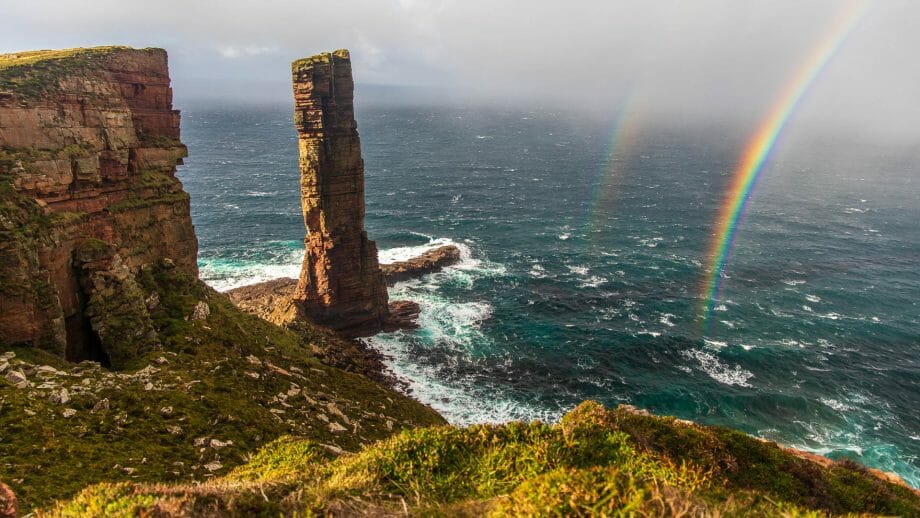It stands like a giant sentinel on the west coast of the Orkney Islands: the Old Man of Hoy. The rocky spire rises almost 140 metres out of the sea – the only question is: for how much longer?

It’s an impressive moment when you come face to face with the Old Man of Hoy. He inspires awe because of his size, he scares you because of the abyss before your feet. Here you can feel nature and life. But even something like the Old Man of Hoy does not last forever: the concern about the survival of the “old man” is justified, as he now only stands on one leg. He was originally given the name Old Man of Hoy because he used to have two legs, i.e. another rocky outcrop to support him. However, a storm in the 19th century washed away his second leg.
The name “Old Man” is somewhat misleading, however, if you compare his lifespan with that of the stone circles on Orkney Mainland, for example. The rock needle is just 400 years young. This is known precisely because nautical charts and artists’ drawings before that only showed a spit of land at this point and later a kind of arch stretching across the sea.
The Old Man of Hoy consists mainly of red sandstone – a relatively soft material. Over time, the sea washed the rock needle out of it. The fact that the Old Man still bravely resists the forces of the waves is due to the fact that it stands on a foundation of hard basalt. In view of the rapid formation, rapid erosion and soft stone, scientists believe that the Old Man of Hoy could soon collapse completely.
The true size of the rocky spire can only be guessed at if you set off on foot. And some people have not only walked there, but also climbed it: the first brave climber dared to scale it in 1966. Since then, the Old Man of Hoy has become a popular destination for free climbers. And in 2008, the first base jumper even threw himself off the top of the rock.
However, if you just want to catch a glimpse, there is another option: if you take the ferry trip between Scrabster on the mainland and Stromness, the boat route takes you right past the rocky spire.
Tour description: Hike to the Old Man of Hoy
Length: approx. 10 km – Duration: approx. 3 hours – Difficulty level: medium
On the approach, turn left down to the car park and do not follow the Old Man of Hoy sign. Park the car and walk back along the road to the fork and now follow the sign to the right.
Walk to the hostel and keep left in front of it.
Go through a gate to the museum houses.
The path is now signposted again and again.
A little further on, the hiker comes across Cra’as Nest. You can also take a quick look at it if you have time. Then return to the path and soon turn right onto a grassy path.
You pass through another footpath gate with a sign indicating that you are now in the RSPB conservation area.
From now on, always follow the path. It soon becomes a gravel path – often not easy because of the rough, loose stones, but it is paved.
The head of the Old Man of Hoy soon appears on the horizon. Head for it.
After the visit to the gigantic rock pillar, return the same way. After the gate at the RSPB sign, however, do not take the grassy path to the left, but follow the dirt track first down and then to the right.
Finally, the walk ends at the car park where it started.
Knowledge: The old man as a film star
The beauty of the Orkneys and the Old Man of Hoy in particular has not escaped the attention of the film makers. In the opening sequence of the music video “Here comes the rain again” by the pop duo Eurythmics from 1983, the viewer is taken on a 30-second flight around the rock needle before Annie Lennox begins to sing. At times, the sky is transformed into a menacing black.
Incidentally, there is also an old farmhouse in Rackwick that serves as a museum reflecting rural life in the 18th century. It is called Cra’as Nest Museum.
How to get there:
Ferry service from the main island runs from Houton to Lyness on Hoy several times a day. Prices vary from around £3 (passenger) to £9 (car). Alternatively, Stromness to Moaness Pier costs around £3 (passenger) – cars are not allowed on this ferry.
Wherever you are coming from, take the B9047 and follow the signs to Rackwick. However, do not turn off to the hostel, but drive to the car park at the end of the road.